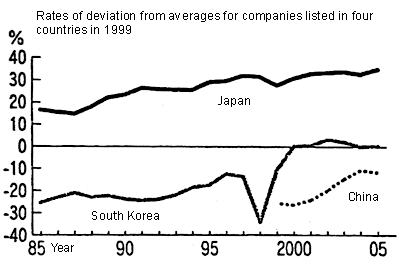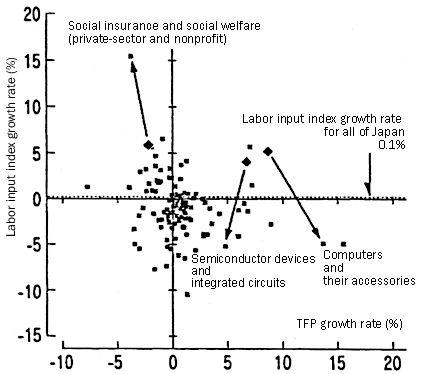Competition is intensifying among companies in East Asia as a result of the appreciating yen and the growth achieved by companies that entered their respective industries relatively late. To what extent have these latecomers caught up with Japanese companies in terms of technology and competitiveness?
To address this issue and various other related topics of interest, a research group at the Japan Center for Economic Research (JCER) that has been investigating the productivity and intangible asset investments of companies in Japan, China, South Korea and Taiwan has updated the East Asian Listed Companies (EALC) database (scheduled for publication at: http://www.jcer.or.jp ) in cooperation with Hitotsubashi University's Center for Economic Institutions, Nihon University's Center for China and Asian Studies (with Professor Tomohiko Inui of Nihon University acting as the project representative) and Seoul National University's Center for Corporate Competitiveness (with Professor Lee Keun of Seoul National University acting as the project representative). In addition to updating the database, the JCER study group performed an international comparison and analysis of investments in intangible assets, which comprise one of the basic factors behind productivity and productivity increases (with this author acting as the chairman).
* * *
The EALC database covers all listed non-financial companies in Japan, China, South Korea and Taiwan. The data required for measuring total factor productivity (TFP) on a corporate level, such as real gross product, intermediate goods, labor and real capital input were collected and then categorized among 33 industries representing the entire non-financial sector of the economy. The international price differences in products, intermediate input and capital goods were adjusted for each of these industries, and the TFP levels for companies in all four countries were compared for presentation in the database. The study group calculated the average TFP levels for all the subject companies in their respective industries in 1999, and then set these levels to zero to analyze the TFP rates of change by comparing them to the average levels. The comparison and analysis covered 1985-2005 for Japan, South Korea and Taiwan, and 1999-2005 for China.
Japanese companies in many industries, including electronics, automobiles and metals, lead East Asia in terms of TFP level, but their TFP growth rates have stagnated. As shown in figure 1 , which compares the sales-weighted average TFP levels for listed automobile manufacturers in Japan, China and South Korea, the TFP level for Japanese automakers was 30% higher than their South Korean counterparts (in other words, they were able to produce 30% more goods with the same production factor input) and 50% higher than Chinese automakers, even as late as 2005. However, their TFP growth rate, as indicated by the broken line, shows a flatter gradient than the rate for the Chinese and South Korean automakers. The gap has been narrowing.
As this example suggests, the database enables users to understand the trends in each East Asian country and region, industry by industry. The TFP levels for Chinese companies show that growth has been steady for companies in machine industries, including electronics and automobiles where active alliances and fierce competition with foreign companies are taking place. On the other hand, TFP growth has been stagnant for Chinese companies in labor-intensive industries, such as textiles and food processing, and industries dominated by monopolistic state-run enterprises, including metals and chemicals. Many of these industries, whose distribution routes are mostly domestic, represent concerns for China as it undergoes a transition to growth dependent on domestic demand.
Taiwan has demonstrated significant growth in TFP levels for companies in industries such as electronics, chemicals and general machinery. The TFP levels for Taiwanese companies in the chemical and general machinery industries have come to rival those of their South Korean counterparts, and they are fast catching up with comparable companies in Japan. In South Korea, the TFP level has failed to rise since the country's currency crisis in the late 1990s. However, some of the South Korean companies with improved TFP levels, particularly financial conglomerate members, are expanding their market share. Average TFP levels for South Korean industries are rising as a result of increased metabolism. In my view, the situation is in sharp contrast to Japan, where productivity gaps among listed companies are small and the metabolic rate has been low.
* * *
Japanese companies in many industries boast higher TFP levels than their counterparts in other East Asian countries. However, the higher TFP levels do not necessarily mean that they are more internationally competitive. International competitiveness depends not only on TFP levels, but also on production costs including wage rates. Japanese companies with stagnant TFP levels are believed to be finding it increasingly difficult to continue production in the face of Japanese wage rates, which are the highest in Asia. This situation is assumed to have led them to shift production overseas. Japanese exports do not disappear even when TFP growth stagnates and goods and services produced in Japan lose their international competitiveness. The exports remain because the loss of competitiveness and hollowing out hold down domestic wage rates and the value of the yen. This is likely to continue until goods and services produced in Japan regain their competitiveness.
Of the countries belonging to the Organisation for Economic Co-operation and Development (OECD), Japan was near third place until the mid 1990s in terms of per-capita gross domestic product (GDP) expressed in U.S. dollars. However, it slipped out to 19th place in 2007. Even when the high value of the yen in recent years is taken into consideration, Japan seems to be still out of the top ten. Stagnant TFP levels for Japanese manufacturers are assumed to be the main cause of this sharp decline in rank. From the production perspective, the falling share of industries sustaining steady TFP growth, particularly information technology (IT), is another cause of concern for Japan.
There is a phenomenon for explaining certain impacts of industrial structure on economic growth known as the Baumol effect. TFP growth rates vary substantially among industries. For this reason, macroeconomic TFP rises faster when industries with high productivity growth rates, such as IT, expand. However, the structure of demand restricts the size of the respective industries. For example, output (production) prices fall in step with significant productivity increases in the IT industry. Production does not increase when domestic demand does not expand very much in response to price declines, and the international division of labor does not result in specialization in the industries concerned. In these conditions, production factor input falls gradually as productivity rises. In other words, industries with high productivity growth rates may experience an eventual decrease in their share of the overall economy, causing macroeconomic TFP growth to drop. This mechanism is called the Baumol effect.
Looking at the 1970-2000 period, a basic negative correlation existed between the increase in labor input and TFP growth in Japan. To put it another way, the decrease in labor input was inversely proportional to TFP growth in industries where the TFP rose significantly, and labor input increased in industries with a low TFP growth rate such as social insurance and social welfare (including nursing care for the elderly). However, many industries, including semiconductors and computers, overcame the Baumol effect and achieved both high TFP growth and greater labor input during this period.
From 2000 onward, labor input in Japan stopped growing in these industries because of various factors including production offshoring. As a result, industries that were able to overcome the Baumol effect virtually disappeared ( figure 2 ). In other words, the industries in the upper right section of the graph decreased in number.
The same analysis was conducted for the United States from 1995 onward, revealing that labor input fell sharply in the manufacturing industries where IT goods were produced. However, many non-manufacturing industries in the U.S., including telecommunications, retail, transportation and financial intermediation sustained high TFP growth and labor input growth at the same time. There is no guarantee that the U.S. will be able to continue its growth pattern after the financial crisis, but I believe that Japan can learn a lesson from the U.S. pattern, where technological innovations in non-manufacturing industries lead TFP and wage rates for the entire economy.
* * *
TFP growth rates for Japanese companies began to recover after 2000 amid an increase in business restructuring activity. Companies began adopting strategies focused on long-term growth, including increased employment of regular workers and accelerated capital investment in the manufacturing industry. The economic crisis, in particular its sharp declines in external demand and the stronger yen, hit the Japanese economy just when it was about to start moving down the path of steady growth.
The ability to develop industries that can sustain both TFP growth and expansion of market share is a critical challenge for Japan because other countries in Asia are fast catching up to it. Japan must accelerate investments in intangible assets, such as information technology, organizations and workers' skills, in addition to enabling its leading edge manufacturers to resume domestic production. The right course for Japan is to avoid the Baumol effect by doing two things: (1) stimulate domestic demand in service areas, such as telecommunications, air transportation, finance and insurance, where productivity growth is high and high-added value is anticipated; and (2) take advantage of its location as an Asian hub to promote the export of Japanese services.

(Source)EALC Database

(Note)Arrows denote changes from 1970-2000 averages to 2000-2006 averages. The author produced this graph using data obtained from the JIP Database 2009.
* Translated by RIETI.
May 8, 2009 Nihon Keizai Shimbun


